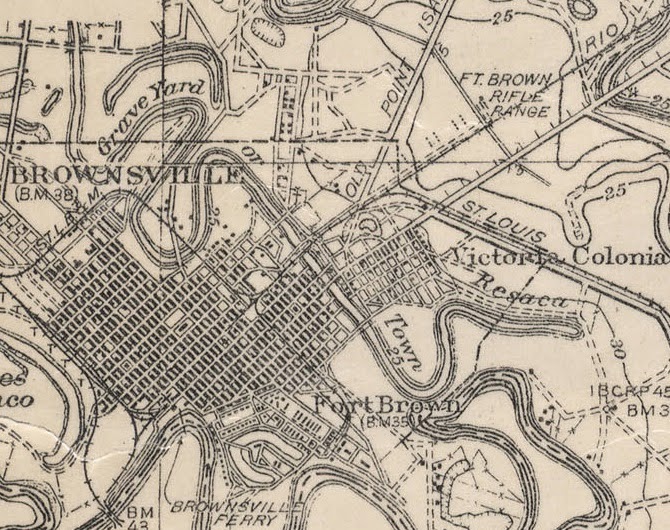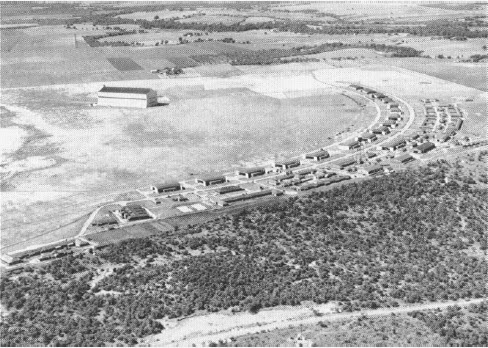Austin:
A map of the DFW area air fields.
Barron Field (Everman)
(added 11/15/18)
(added 11/15/18)
Love Field (Dallas)
(added 11/15/18)
(added 11/15/18)
Unlike many other fields in Texas, Love Field got some love, and did see re-use during WWII. In fact, it's the busiest civilian airport that was founded during the WWI era. Southwest Airlines got their start here.
Taliaferro Field (Hicks)
(added 11/15/18)
(added 11/15/18)
El Paso:
Ft. Bliss
 |
| Circa 1907. |
Houston/Galveston:
Ft. Crockett
Ellington Field
(added 11/15/18)
(added 11/15/18)
Camp Logan was one of 16 National Guard tent camps. It didn't see any WWII reuse. But it had racial riots because of black soldiers being targeted by Houston's finest.
Park Place Aviation Depot
Ft. San Jacinto
Ft. San Jacinto
Ft. Travis
Rio Grande Valley area:
Due to the Mexican Revolution, incursions along the border were common. Thus, the United States build up a lot of posts along the border. (Many of which do not show up on WWI base maps.) The major factor that got the United States to go from being "neutral" to an active participant in the war, was an intercepted telegram from Germany (to Mexico) offering financing to Mexico to invade the United States. After that, all bets were off!
Ft. Brown
Ft. Clark
Camp Dolores
 |
| Circa 1907. |
The Fort was originally named Fort Texas and was established along the border in 1846. It was re-named after Army Officer Jacob Brown who stationed at the Fort and fought against the Mexican Army after they crossed the Rio Grande in April 1846. The fort also saw use during WWII and hosted the 12th Calvary from WWI to 1941.
After WWII, Fort Brown was declared surplus and was disposed of. The main historical core now sits on what is the University of Texas Pan American.
After WWII, Fort Brown was declared surplus and was disposed of. The main historical core now sits on what is the University of Texas Pan American.
Ft. Clark
Camp Dolores
Ft. McIntosh
Ft. Ringold
 |
| Brooks in the early 1920s. |
| |||||||||
Brooks field started off being known as "Kelly Field No. 5". The Air Force retained Brooks until a base closure round in 2005. It has a very interesting history. For example, Johnny Cash trained there in 1950. And, in John F. Kennedy's last official act as president, he dedicated a medical building before he was assassinated in Dallas on November 22, 1963. It was last known as "Brooks City Base". Flying operations ceased in the 1960s.
 |
| Kelly Fields 2 and 3. |
Circa 1920s
Fort Sam Houston was named after the first president of the Republic of Texas. Ft. Sam eventually absorbed the national army training base Camp Travis and is still part of the base today. It appears that none of the Salado Creek Drill Grounds were absorbed. But the vast majority of S.C.D.G and Remount Station No. 2 are now part of the million plus resident city San Antonio. The first official army flight occurred at Fort Sam Houston in 1911.
Camp Travis was one of 16 National Army cantonments. It was originally called Camp Wilson named after President Woodrow Wilson who had campaigned for election in 1916 to "keep us out of the War". He lied. The Camp was subsequently renamed after Alamo hero William B. Travis. It hosted the 90th Infantry Division consisting of troops from Oklahoma and Texas. At its peak the camp consisted of 18,290 acres. The main part of the camp abutting Fort Sam Houston consisted of 5,730 acres.
Camp John Wise
(added 11/15/18)
(added 11/15/18)
Camp John Wise was named after aviation pioneer John Wise who set a distance record in an air balloon in 1869. It was a balloon training base consisting of 261 acres. Troops were quartered at nearby Fort Sam Houston. It appears that it did not see any WWII reuse.
San Antonio Arsenal
San Antonio Arsenal was founded in 1859, and was occupied by Confederate forces during the Civil War. Afterwards, the U.S. Government regained control and slightly enlarged it for WWI. By the end of the war, there were 38 buildings. Not only during WWI was it a major supply center, During WWII it was also very busy. In 1949, it was declared surplus.
Camp Stanley
It was named after Brigadier General Davis Stanley. During WWI it first served as a sub post for the San Antonio Arsenal. Then in 1922 it was a training area for Camp Travis. Today, it is the Leon Springs Military Reservation.
Waco:
 |
| Rifle Range of Camp MacArthur circa 1918. |
Camp MacArthur was one of 16 National Guard tent camps.It was named after General Arthur MacArthur, who was the father of WWII hero Douglas MacArthur. It consisted of 10,699 acres. It did not see any WWII reuse. It hosted the 32nd Division. Draftees came from Michigan and Wisconsin. The base closed on March 7, 1919. It was ordered salvaged to provide material to improve some posts along the Mexican border.
Rich Field
This is among the majority of WWI air fields there is no civilian aviation reuse today. It was adjacent to Camp MacArthur. It did see some use during WWII as a contract school. A high school now sits on the property. It was called "Richfield" High School before being changed to Waco High School.
Wichita Falls:
Call Field
































No comments:
Post a Comment